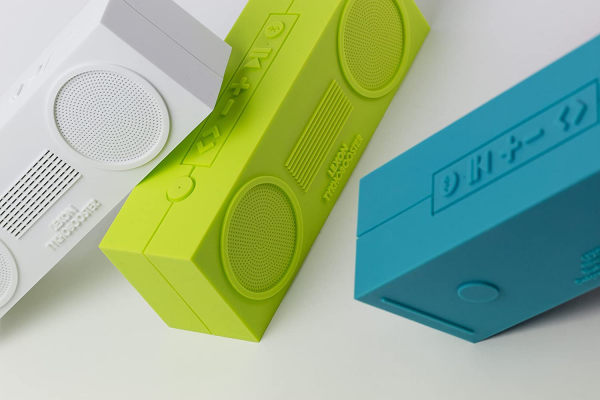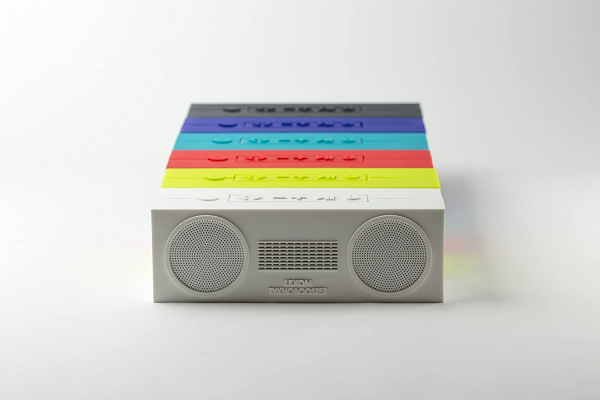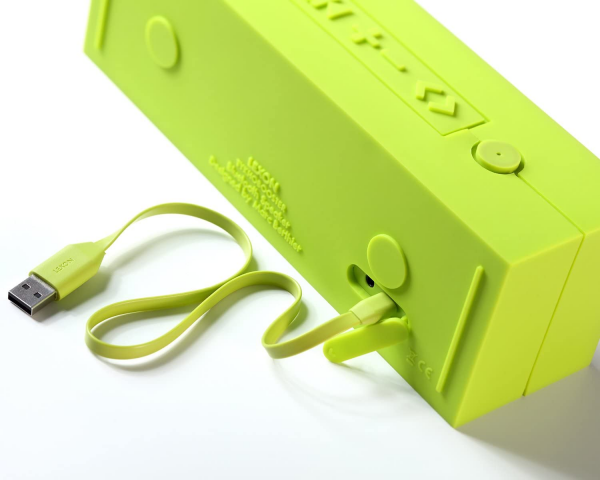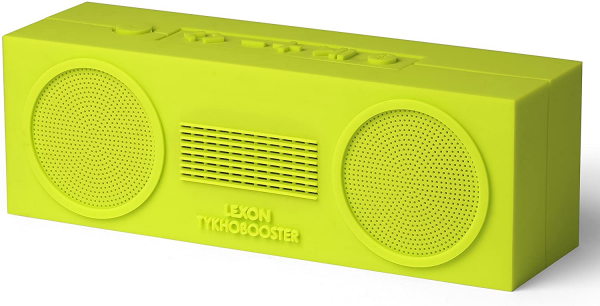Lexon
Lexon Tykho Booster: plumage rather than ramage
Aprox. 30€
See specificationsBeing part of the "Deco Trend collection" of the French design company Lexon, the Tykho Booster is a speaker that relies above all on its trendy plastic to attract potential buyers, rather than on promises of technical prowess. This does not exempt it from undergoing the law of our test bench.
Positive points
Complete orders.
Resistance to splashes.
Bad points
Its imprecise, unbalanced and not very powerful (and which saturates at high volume).
Autonomy (6 hours).
Very poor manufacturing and messy finish.
Noise reduction perfectly ineffective on the microphone of the hands-free kit.
Our review
Ergonomics
A minimalist monochrome rectangular parallelepiped, of rather good size, but with a high content weight (700 grams, barely more than a Bose Soundlink Mini II), available in a multitude of candy colors, the Tykho Booster seems to assert with great confidence its modernity . Difficult however to see in this exercise of design a success. If we let each judge the elegance of the lines, we regret a frankly inappropriate choice of material. The body of the speaker is indeed made of an extremely messy silicone rubber, which attracts and grips with incredible stubbornness fingerprints, dust and other hair. We dare not imagine what kind of horror could occur if the enclosure were to be installed in a pet owner with fur.
The painting is still tarnished by a fairly rustic assembly. This is evidenced, for example, by the upper panel housing the control buttons, fixed to the chassis of the enclosure by a simple notch system ... and which completely updates the control printed circuit when it is removed. For an enclosure supposed to be resistant to splashing - or at least "being able to be handled with wet hands" - the thing does not inspire confidence.
Since we talked about the control buttons, it must be said that we appreciate their completeness. There are buttons for the previous / next track, volume control, play / pause, as well as a multifunction Bluetooth button; a short press allows you to pick up or hang up during a call, while a long press allows you to start pairing - note in passing that the Tykho Booster is unfortunately only able to memorize a single paired Bluetooth device. Next to this button is also a microphone allowing you to use the speaker as a hands-free kit. We will come back to the performance of this microphone in the audio part.
Bluetooth connectivity is complemented by a simple analog auxiliary input on 3.5 mm mini-jack. As for autonomy, we measured it at around 6 hours for a listening level set at around 75% of the maximum volume. It's very thin.

Audio
Let's immediately get rid of the question of the performance of the wired speaker: they are disastrous. Bypassing its signal processing stages, the Tykho Booster then provides a completely skimpy sound, exclusively focused on the mids. It is hardly better than a hands-free kit.
In Bluetooth, the speaker activates its DSPs to enhance as much as possible the energy produced at the ends of the spectrum - both in the bass and in the treble. Enough to make listening enjoyable? Alas no, far from it. The frequency response remains very unbalanced, with a strong emphasis on the high mids which give the sound a very nasal character, and even a slight megaphone effect. A feeling to also put on the account of bass which remains far too light; despite the presence of a passive radiator, they seem to remain trapped inside the enclosure, absorbed by its silicone envelope. An impression confirmed by the very strong vibrations of the speaker when it is operating. Vibrations that show how bad the decoupling of the speakers and the chassis is. And these vibrations are obviously not without sound effect: as long as the Tykho Booster is placed on a somewhat rigid surface or on a piece of furniture with some resonance, we must then expect significant acoustic inconvenience.
Regardless of all this, we still deplore a sound singularly lacking in precision. The instruments loosen very badly from each other, their timbres struggling without success to extricate themselves from a very rough sound message. As if that weren't enough, you still have to reckon with unnatural, fairly acid trebles, which greatly contribute to the sensation of a very flat sound, as if devoid of dynamics.
No comfort to seek either on the side of available power: it is frankly limited and disappointing in relation to the size of the speaker. This is all the more true since it is necessary at all costs to avoid pushing the volume beyond 75%, under penalty of hearing an extremely pronounced and unpleasant saturation appear on the transients.
Any last for the road? Stereophony is also extremely disappointing. Unless you stick a few inches from the speaker, it is almost invisible. Let us note all the same at least that the directivity of the speaker is rather contained: no need to stand well in front of it to hear "correctly" its music. And since the bass radiator is located on the same side as the active speakers, we can position the speaker on its back to make it radiate upwards and thus approach in a way a 360-degree emission. It's always taken ...
At this point, no one will be moved by anyone who says that the microphone of the integrated hands-free kit is also very unsatisfactory in use. It incorporates particularly ineffective noise reduction, which almost constantly fails to separate the speaker's voice from the surrounding noise. Do not throw any more.

Conclusion
The few qualities that can be found in the Tykho Booster do not weigh very heavy in the face of its gross faults, in the forefront of which we find quite calamitous sound performances. No more success on the design side, which may seem attractive in photos, but which is frankly unconvincing in reality. An enclosure to be avoided.

Specifications

